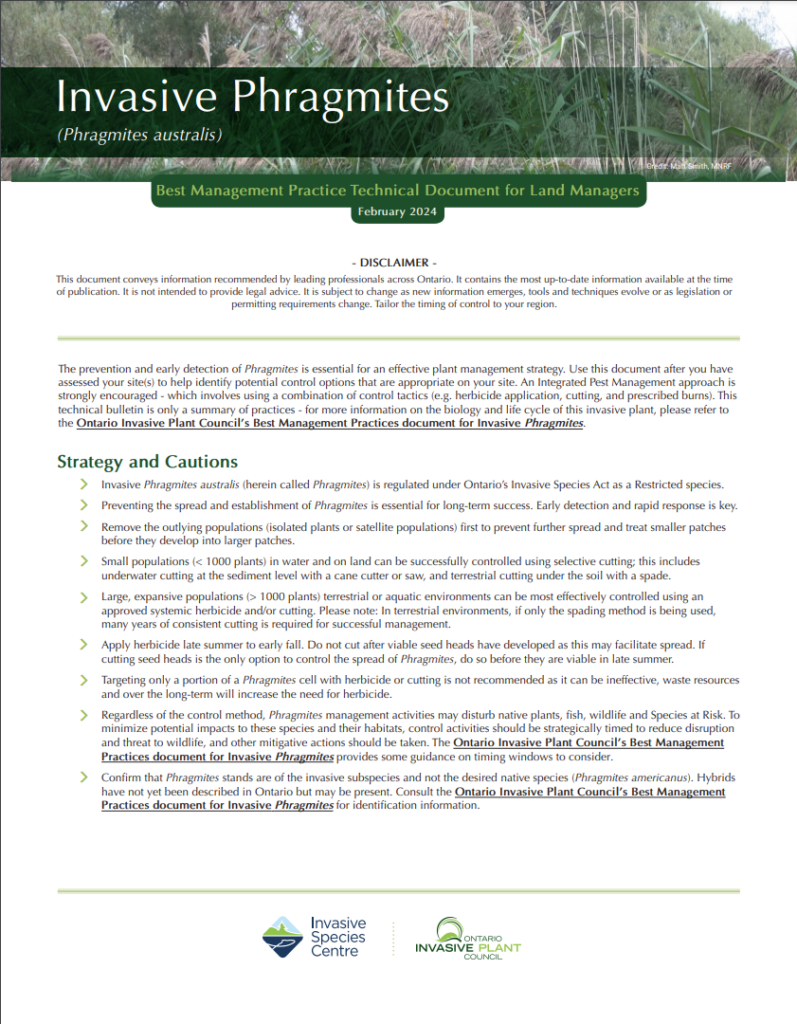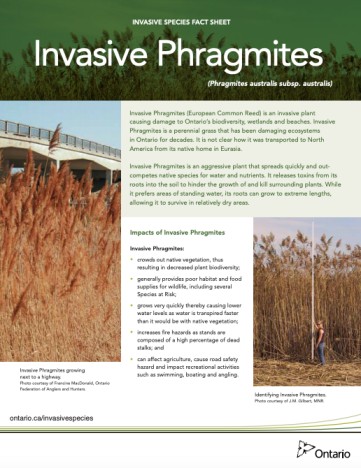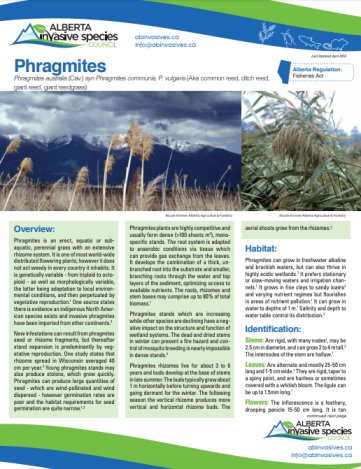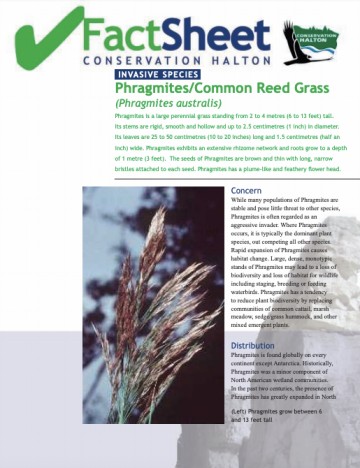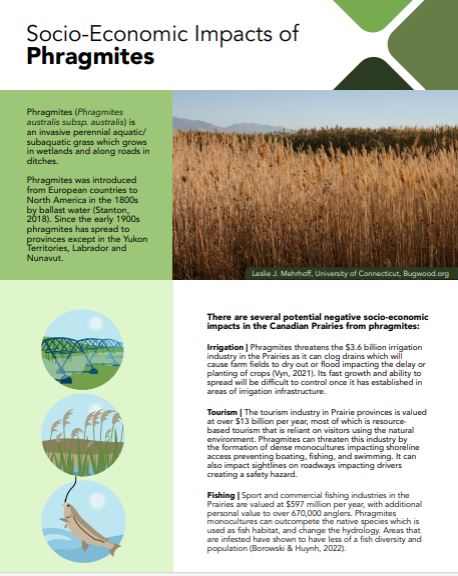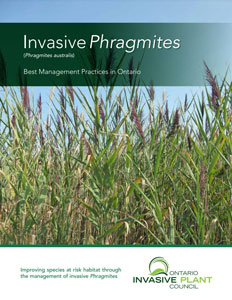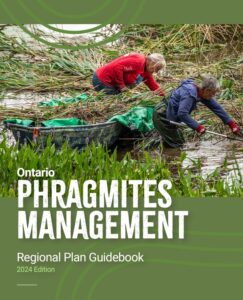Common Reed (Phragmites)
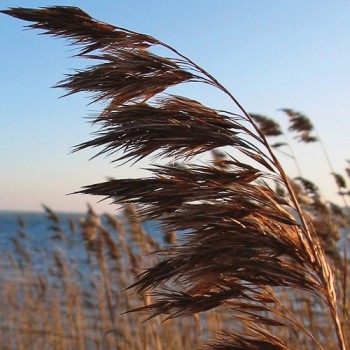
An aggressive plant that spreads quickly and outcompetes native species for water and nutrients.
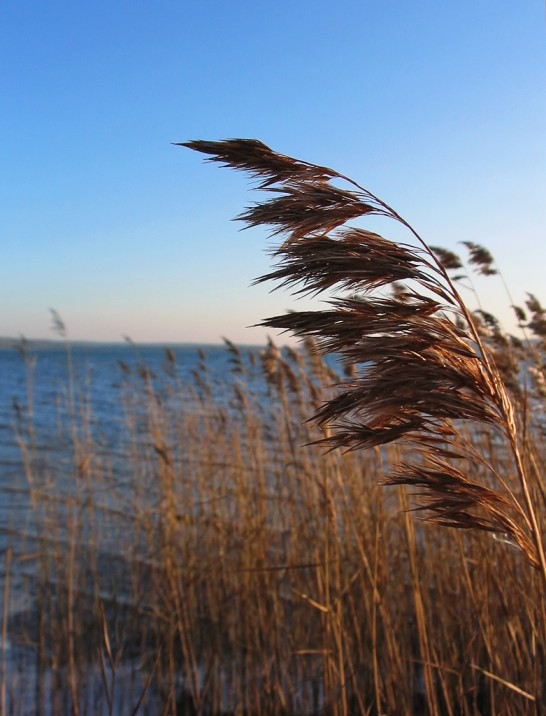
Invasive phragmites reproduces by dispersing seeds, by roots via rhizomes, or by stolon fragments.
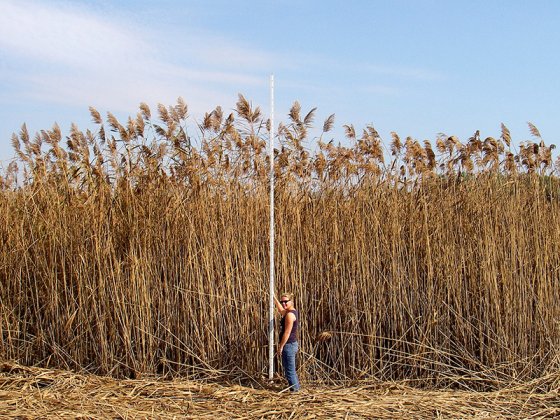
Phragmites can reach heights of 5 meters (15 feet).
Photo by Janice Gilbert
French common name: Roseau commun
Order: Poales
Family: Arundinoideae
Invasive phragmites is an aggressive plant that spreads quickly and outcompetes native species for water and nutrients. Biochemicals are released from its roots into the soil to hinder the growth of surrounding plants. Identifying this invasive can be difficult due to the existence of native subspecies. Invasive phragmites generally reaches heights of up to 5 metres and has stems that are tan in colour with blue-green leaves and large, dense seed heads. It can grow so densely that it crowds out other species, while native phragmites is typically not as dense and doesn’t impede biodiversity.
Phragmites is a robust erect perennial grass, aquatic or subaquatic, growing to 4 m in height (occasionally 6 m), strongly tufted, with an extensive rhizome system. It has rigid, many-noded stems and hollow internodes. Leaves alternate and are up to 70 cm long, with a ligule of hairs up to 1.5 mm long. Leaf blades are flat, up to 60 cm long and 8-60 mm wide.
Invasive vs. native
The invasive subspecies of phragmites (Phragmites australis) looks very similar to a native species (Phragmites americanus), and it is imperative that a stand be identified as invasive before implementing a management plan. When large-scale control is planned, any stands of native phragmites should be protected. Unlike the invasive strain, native phragmites rarely develops into monoculture stands, does not alter habitat, has limited impact on biodiversity, and does not deter wildlife. It can be difficult to tell native and invasive phragmites apart and genetic analysis may be necessary. Some identifying characteristics that may help tell the species apart are:
- Stand height
- Stand density
- Stem colour
- Leaf colour
- Seedhead density
Invasive phragmites stands can grow up to 5 m tall (15 ft) in very dense stands with up to 200 stems per square metre. These near-monoculture stands can consist of 100% invasive phragmites. In comparison, native phragmites does not grow as tall and does not outcompete other native species, so there is more diversity within a stand (Phragmites BMP).
Invasive phragmites stems are generally tan or beige in colour, with blue-green leaves and large, dense seedheads. In contrast, native phragmites has reddish-brown stems, yellow-green leaves, and smaller, sparser seedheads.
Cross-breeding between invasive and native plants has not been confirmed in the field, but has been produced in laboratory studies. Where the plant is found in certain environmental conditions, such as those that occur along sandy coastal shorelines and deep water systems, the morphological differences described above are not definitive. If it is not clear whether a phragmites plant is invasive or native, it is recommended that an expert be consulted (Phragmites BMP).
Impacts of invasive phragmites (BMP)
- Crowds out native vegetation, resulting in decreased plant biodiversity
- Provides poor habitat and food supplies for wildlife, including several species at risk
- Grows very quickly, causing lower water levels as water is transpired faster than it would be with native vegetation
- Increases fire hazards as stands are composed of a high percentage of dead stalks
- Can affect agriculture, cause road safety hazards, and impact recreational activities such as swimming, boating, and angling
Loss of biodiversity and species richness
Invasive phragmites causes a decrease in biodiversity by creating monoculture stands (meaning only one species grows in the stand). Stands crowd out native vegetation and hinder native wildlife from using the area, resulting in a decrease in both plant and animal biodiversity.
Loss of habitat
Monoculture invasive phragmites stands reduce available natural habitat and food supply for various wildlife species, which can include species at risk. Stalks are rigid and tough and prevent wildlife from easily navigating through or nesting in a stand.
Changes in hydrology
Invasive phragmites displays very high metabolic rates, which can lead to changes in the water cycles of an ecosystem. Monoculture stands have the ability to lower water levels, as water is transpired at a faster rate than it would be in an area of native vegetation.
Changes in nutrient cycling
Invasive phragmites stalks are made of a very inflexible structural material which breaks down very slowly. This slows the release of nutrients and leaves a high proportion of recalcitrant biomass (carbon) in the standing dead stalks.
Increased fire hazards
A stand is composed of a high percentage of dead stalks, with a lower percentage of live growth. Dead stalks are dry and combustible, increasing the risk of fires.
Economic and social impacts
Invasive species can have many negative effects on the economy and social wellbeing. Effects on agriculture and crops can lead to economic losses, while monoculture stands can affect property values and raise aesthetic concerns.
You can help reduce the spread of invasive phragmites by learning how to identify it and avoid accidentally spreading it through root fragments and seeds. This is especially important if you are planning to work in an area which contains invasive phragmites (BMP):
- Do not plant invasive phragmites. Native phragmites has the same appearance and does not pose an ecological risk.
- Use only native or non-invasive plants in your garden and ask garden centres for plants that are not invasive.
- Stay on designated trails. Leaving trails or entering areas containing invasive stands can encourage the spread of this plant. When leaving an area containing invasive phragmites, brush off clothing and clean equipment onsite to avoid the transfer of seeds to new areas. Remove all visible portions of plants and dispose of them in the garbage.
- Do not compost invasive phragmites. Both seeds and rhizomes (horizontal plant stems growing underground) can survive and grow in compost.
- In Ontario, it is illegal to import, deposit, release, breed/grow, buy, sell, lease or trade invasive phragmites, as it is restricted under the Invasive Species Act. For more information on handling invasive phragmites and other species in accordance with the Invasive Species Act, visit the Ontario government resource Managing Invasive Species in Ontario.
Technical Bulletins
Invasive Phragmites Technical Bulletin
This document conveys information recommended by leading professionals across Ontario. It contains the most up-to-date information available at the time of publication. It is not intended to provide legal advice. It is subject to change as new information emerges, tools and techniques evolve or as legislation or permitting requirements change. Tailor the timing of control to your region.
These documents were produced by the Ontario Invasive Plant Council with support from the Invasive Species Centre.
Fact Sheets
Management Resources
Developed by the Green Shovels Collaborative, this guide is designed to support municipalities and their regional partners throughout their Phragmites eradication projects. It provides a step-by-step framework from start to finish aiming to be the one-stop resource to help with launching your Phragmites program. Each step is supported by tips with suggestions and links to province-wide resources including Best Management Practices (BMPs) derived from real Phragmites management projects in Ontario.
Research
Phragmites australis (P. communis): threats, management and monitoring.
described in detail including the global range of P. australis, its natural habitat and its
biology/ecology. The recovery potential of areas invaded by P. australis and the …
Expansion of Phragmites australis into tidal wetlands of North America
northern and middle Atlantic coasts, but over 80% of the US coastal wetland area occurs
along the Gulf of Mexico and southern Atlantic coasts and may be susceptible to ongoing …
The effects of salinity and flooding on Phragmites australis
under various salinity and flooding conditions in a greenhouse for one growing season. 2. P.
australis buds did not emerge from cores flooded to the soil surface, regardless of salinity …
A comparison of Phragmites australisin freshwater and brackish marsh environments in North America
ecologicalfactors affecting Phragmites australis in inlandfreshwater, tidal fresh, and tidal
brackish marshsystems. We compare aboveground productivity, plantspecies diversity, and …
Phragmites australis– A preliminary study of soil‐oxidizing sites and internal gas transport pathways
were investigated by means of pressurized air flow, methylene‐blue dye and by anatomical
studies. In most cases, gas was easily forced through the plants, thus demonstrating gas …
Current Research and Knowledge Gaps
Further Reading
The Invasive Species Centre aims to connect stakeholders. The following information below link to resources that have been created by external organizations.

